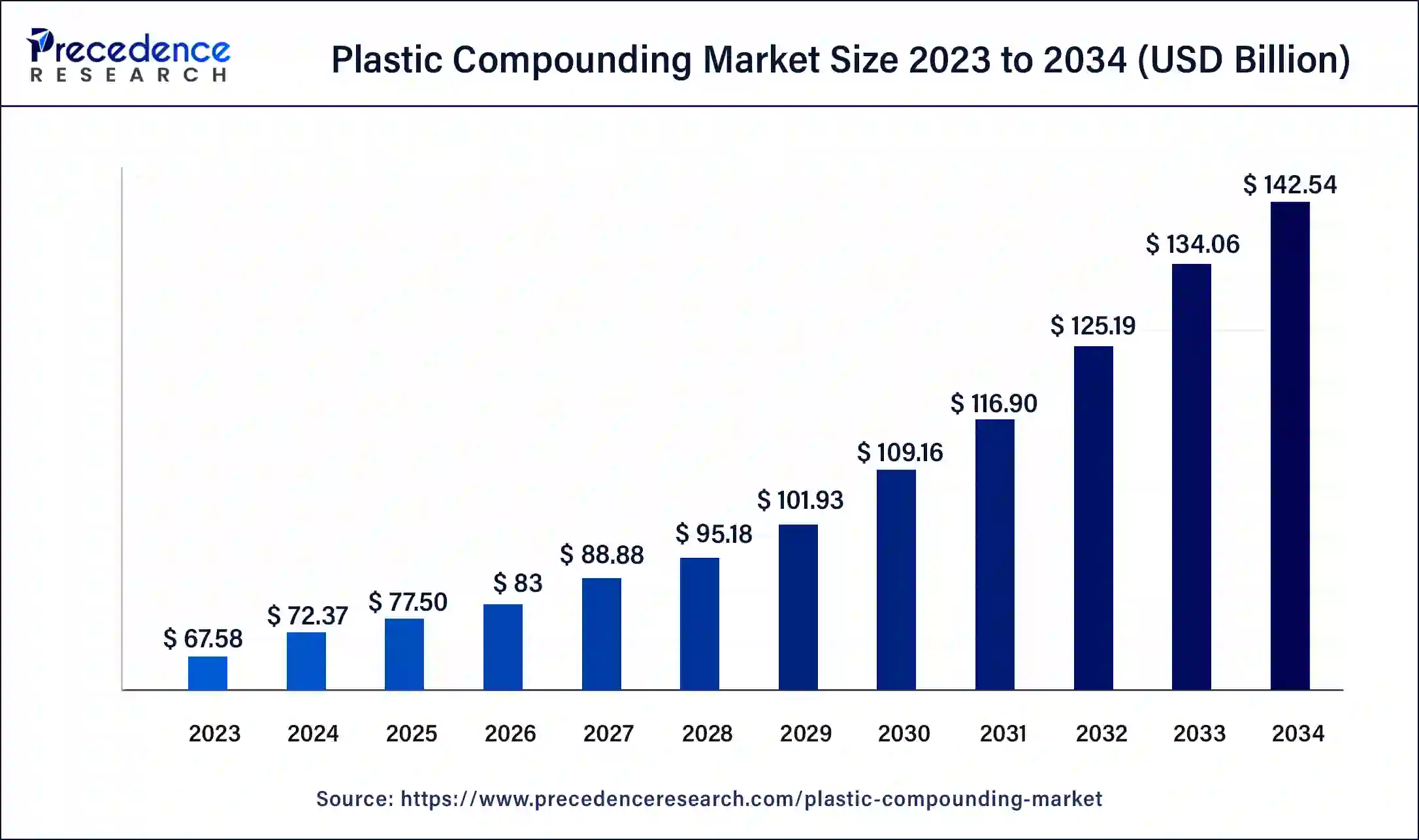The global plastic compounding market is projected to grow from USD 72.37 billion in 2024 to USD 142.54 billion by 2034, expanding at a CAGR of 7%.
- Asia Pacific dominated the plastic compounding market in 2023, holding a 46% share.
- The automotive sector led by application, contributing over 26% of the total revenue in 2023.
- Polypropylene (PP) emerged as the top product, capturing a 33% market share in 2023.
Overview
The plastic compounding market is a dynamic and integral segment of the global materials industry, focusing on enhancing the properties of base polymers through the incorporation of additives such as fillers, colorants, and stabilizers. This process tailors plastics to meet specific performance requirements across various applications, including automotive, construction, packaging, and electronics. As of 2023, the market was valued at approximately USD 69.2 billion and is projected to reach around USD 156.4 billion by 2032, reflecting a compound annual growth rate (CAGR) of 9.6%.
Drivers:
Several factors are propelling the growth of the plastic compounding market. The automotive industry’s increasing demand for lightweight materials to improve fuel efficiency and reduce emissions has led to a higher adoption of compounded plastics, which offer a favorable strength-to-weight ratio. In the construction sector, the versatility and durability of compounded plastics make them ideal for applications such as piping, insulation, and window profiles. Additionally, advancements in polymer technology have expanded the use of plastic compounds in electrical and electronics industries, where properties like electrical insulation and heat resistance are critical. The packaging industry also contributes to market growth, with compounded plastics providing essential characteristics such as flexibility, strength, and barrier protection.
Opportunities:
The market presents significant opportunities, particularly in the development of sustainable and eco-friendly plastic compounds. Growing environmental concerns and stringent regulations are driving the demand for biodegradable, recyclable, and bio-based plastics. Companies investing in research and development to create such sustainable solutions are poised to gain a competitive advantage. Emerging applications in medical devices and renewable energy sectors also offer new avenues for growth. In healthcare, the need for biocompatible and sterilizable materials is increasing, while the renewable energy sector requires durable and weather-resistant plastics for components in solar panels and wind turbines.
Challenges:
Despite the positive outlook, the plastic compounding market faces challenges, notably the volatility of raw material prices, which can impact production costs and profit margins. The reliance on petrochemical feedstocks makes the industry susceptible to fluctuations in oil prices. Additionally, environmental concerns regarding plastic waste have led to stricter regulations, compelling manufacturers to adopt sustainable practices and develop eco-friendly products. The need for continuous innovation to meet regulatory standards and consumer expectations adds to the complexity of the market landscape.
Regional Insights:
The Asia Pacific region dominates the plastic compounding market, accounting for over 44% of the global revenue in 2023. This dominance is attributed to rapid industrialization, urbanization, and a burgeoning manufacturing sector in countries like China, India, and Japan. The automotive and electronics industries in these nations significantly contribute to the demand for compounded plastics. Europe holds a substantial market share, driven by a well-established automotive industry and a strong emphasis on sustainability and environmental regulations. North America also represents a significant portion of the market, with advancements in technology and a focus on high-performance materials across various industries.
Recent News:
In December 2023, Sirmax, an Italian plastic processor, announced plans to expand its plastic compounding operations in India, aiming for a production capacity of 20 kilotons per annum by the end of 2026. This move underscores the growing demand for compounded plastics in the Indian market. In November 2023, Borealis AG expanded its production of mechanically recycled plastic compounds, increasing its capacity to over 50 kilotons per annum through the acquisition of Rialti S.p.A., an Italian polypropylene compounder specializing in recyclates. These developments reflect the industry’s shift towards sustainability and the increasing importance of recycled materials in plastic compounding.
Plastic Compounding Market Companies
- BASF SE
- Asahi Kasei Plastics
- The Dow Chemical Company
- LyondellBasell Industries N.V.
- SABIC
Segments Covered in the Report
By Application
- Electronics & Electrical
- Automotive
- Packaging
- Building & Construction
- Industrial Machinery
- Optical Media
- Consumer Goods
- Medical Devices
- Others
By Product
- Thermoplastic Polyolefins (TPO)
- Poly Vinyl Chloride (PVC)
- Polypropylene (PP)
- Polyethylene
- Thermoplastic Vulcanizates (TPV)
- Polystyrene
- Polybutylene Terephthalate (PBT)
- Polycarbonate
- Acrylonitrile Butadiene Styrene (ABS)
- Polyethylene (PET)
- Polyamide
- PA 6
- PA 66
- PA 46
- Others
By Source
- Fossil-based
- Bio-based
- Recycled
By Regional Outlook
- North America
- U.S.
- Canada
- Europe
- U.K.
- France
- Germany
- Italy
- Asia Pacific
- China
- Japan
- India
- Latin America
- Middle East & Africa
- Saudi Arabia
- South Africa
